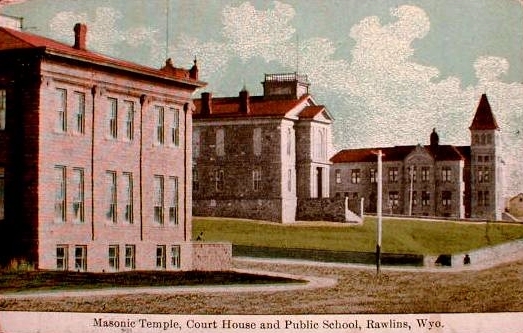 Rawlins, Wyo., 1910, L. to R. Masonic Temple, Court House, and
High School.
Rawlins, Wyo., 1910, L. to R. Masonic Temple, Court House, and
High School.
As is suggested by the photographs on this and the
preceding page, Rawlins at first was a bit wild. In July 1878 the town became for a short
time the center of the scientific world when visitors from all over the world
descended upon the area for a total eclipse of the sun. Among those who came was
Thomas A. Edison who described his stay:
"There were astronomers from nearly every nation. We had a special car.
The country at that time was rather new; game was
in great abundance, and could be seen all day long
from the car window, especially antelope. We arrived
at Rawlins about 4 P.M. It had a small machine
shop, and was the point where locomotives
were changed for the next section. The hotel was a
very small one, and by doubling up we were barely
accommodated. My room-mate was Fox[1], the correspondent
of the New York Herald. After we retired
and were asleep a thundering knock on the door
awakened us. Upon opening the door a tall, handsome
man with flowing hair dressed in western style
entered the room. His eyes were bloodshot, and he
was somewhat inebriated. He introduced himself as
`Texas Jack'--Joe Chromondo--[sic][2]and said he wanted
to see Edison, as he had read about me in the newspapers.
Both Fox and I were rather scared, and
didn't know what was to be the result of the interview.
The landlord requested him not to make so
much noise, and was thrown out into the hall. Jack
explained that he had just come in with a party
which had been hunting, and that he felt fine. He
explained, also, that he was the boss pistol-shot of
the West; that it was he who taught the celebrated
Doctor Carver[3] how to shoot. Then suddenly pointing
to a weather-vane on the freight depot, he pulled
out a Colt revolver and fired through the window,
hitting the vane. The shot awakened all the people,
and they rushed in to see who was killed. It was
only after I told him I was tired and would see him
in the morning that he left. Both Fox and I were so
nervous we didn't sleep any that night. We arrived
at Rawlins about 4 P.M. It had a small machine
shop, and was the point where locomotives
were changed for the next section. The hotel was a
very small one, and by doubling up we were barely
accommodated. My room-mate was Fox[1], the correspondent
of the New York Herald. After we retired
and were asleep a thundering knock on the door
awakened us. Upon opening the door a tall, handsome
man with flowing hair dressed in western style
entered the room. His eyes were bloodshot, and he
was somewhat inebriated. He introduced himself as
`Texas Jack'--Joe Chromondo--[sic][2]and said he wanted
to see Edison, as he had read about me in the newspapers.
Both Fox and I were rather scared, and
didn't know what was to be the result of the interview.
The landlord requested him not to make so
much noise, and was thrown out into the hall. Jack
explained that he had just come in with a party
which had been hunting, and that he felt fine. He
explained, also, that he was the boss pistol-shot of
the West; that it was he who taught the celebrated
Doctor Carver[3] how to shoot. Then suddenly pointing
to a weather-vane on the freight depot, he pulled
out a Colt revolver and fired through the window,
hitting the vane. The shot awakened all the people,
and they rushed in to see who was killed. It was
only after I told him I was tired and would see him
in the morning that he left. Both Fox and I were so
nervous we didn't sleep any that night.
Above right, John B. "Texas Jack" Omohundro, see
notes below
"We were told in the morning that Jack was a
pretty good fellow, and was not one of the `bad
men,' of whom they had a good supply. They had
one in the jail, and Fox and I went over to see him. A
few days before he had held up a Union Pacific train
and robbed all the passengers. In the jail also was a
half-breed horse-thief. We interviewed the bad man
through bars as big as railroad rails. He looked like
a `bad man.' The rim of his ear all around came
to a sharp edge and was serrated. His eyes were nearly
white, and appeared as if made of glass and set in
wrong, like the life-size figures of Indians in the
Smithsonian Institution. His face was also extremely
irregular. He wouldn't answer a single question.
I learned afterward that he got seven years in prison,
while the horse-thief was hanged. As horses ran
wild, and there was no protection, it meant death
to steal one."
[Webmaster's notes: 1. Probably Edward Fox, correspondent for the New York Herald
in the 1870's. 2. Reference to
Texas Jack is to John B. "Texas Jack" Omohundro (1846-1880). Omohundro was
born in Virginia and went to Texas at age 15. During the Civil War he returned
to Virginia and served as a scout for C.S.A General J. E. B. Stuart. He subsequently
returned to Texas and received the name "Texas Jack" on a cattle drive to
Tennessee. In the late 1860's he made the acquaintance of Wm. F. Cody, James Butler "Wild Bill" Hickok,
and Ned Buntline in Kansas. He returned east with Cody and Buntline and starred
in a Wild West Show and was later made famous, together with
Cody and Hickok, in some of Buntline's Dime Novels. In 1872 Omohundro served along with
Wm. F. Cody as a guide for the Grand Duke Alexis on his hunting trip to
Nebraska and Wyoming. The same year he
participated as trail agent in the last successful Pawnee buffalo hunt. The government required that
an agent accompany Indians on hunts so as to preclude the Indians from
leaving their appropriate territory or harrassing settlers. In the
next hunt in 1873 an inexperienced agent was employed by the Pawnee Nation and
the hunt ended unsuccessfully at the Battle of Massacre Creek. Later Omohundro played
with Hickok in a touring drama Scout of the Plains. Omohundro died in Leadville in
1880. Cody paid for the stone grave marker marking his burial site.
3. Doctor Carver, "Doctor" William F. Carver, a Texas marksman who toured with
Cody's Wild West Show, now most famous as the inventor in 1927 of the "Diving Horse" act
in Atlantic City, N. J., in which a horse and scantly clad young lady would dive from a forty-foot high
platform into a 12-foot deep tank.]
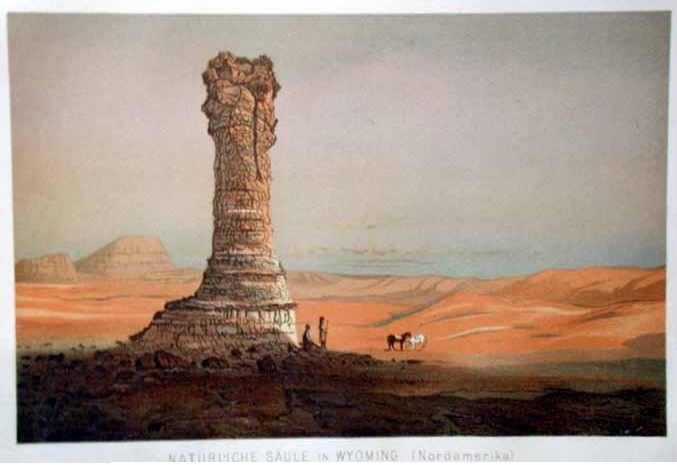
Natural Piller, Washakie Badlands, chromolithograph by Julius Bien from a
drawing by Gilbert Munger, Clarence King's 40th Parallel Geological Survey, 1869
Clarence King (1842-1901), a California geologist, in 1869 began a geological survey across the
west along the 40th parallel. Gilbert Munger (1837-1903) was the expedition's guest artist. Due to his
knowledge of geology, Clarence King is today remembered as the one who exposed one of the
great business frauds of the 19th Century. The fraud also left one of the great unsolved mysteries of Wyoming.
To the west of Baggs and southwest of Rawlins in southeastern Sweetwater County lies a desolate
area known as the Washakie Basin. Today most of the area is accessible only by occassional Jeep trails, and those
are few and far between. The appearance of the area can be pictured in the mind's eye by the place names of the Basin:
"Washakie Badlands," "Poison Draw,"
"Hells Canyon," "Poison Basin," "Colloid Draw, and "Poison Buttes."
In 1872, in this area, John Slack and John Arnold reported the
discovery of a rich diamond field. In order to convince potential investors of
the legitimacy of the find, a well-known and respected engineer and some of
the investors were brought to Rawlins and taken on a three-day trek, blindfolded so that would not
know where they were, to a lonely butte.
There they were shown the diamond field with diamonds everywhere, under the ground, in
rock crevices and on the surface waiting to be picked up. The engineer reported that $1,000,000 a month could be expected from a mining
operation. Stock was sold. Unfortunately for the investors, Clarence King, due to his
knowlege of the area, was able to deduce the location, examined the site, and, with his knowlege of
rocks, determined that some of the diamonds were cut and
polished. Investigation found that the year before Arnold and Slack had purchased
some $40,000 worth of low grade diamonds in London. Arnold was arrested in Kentucky where he was
found with the proceeds of the stock sale. Slack was never found, leading to the
suspicion that he may have been done in by his partner. The site of the
diamond mine and the balance of the $40,000 worth of diamonds has never been
found. Some believe that the location may be near Vernal in Utah, others believe it to be in
northern Colorado, and yet others contend that it is not more than 40 miles from Rawlins. The irony is
that the state geological survey reports that there is a very real possibility of
diamonds in the state, but as a result of Slack and Arnold's fraud any interest
in diamond exploration in the state had been deterred for over 100 years.
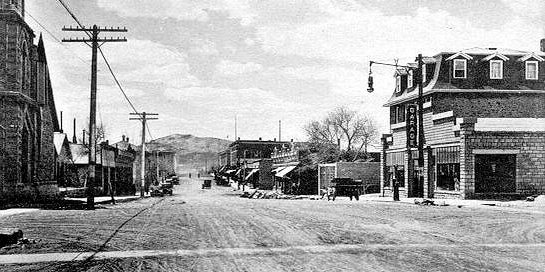
Lincoln Highway, Rawlins
Undated photo of freighters in Rawlins, lower left.
Note the crosswalks in the street. Similar stone
or concrete crosswalks will be observed in early photos of Laramie and Sheridan on
their respective pages. As is observed with regards to the discussion of Laramie, the Lincoln
Highway did not come to Wyoming until after World War I. Indeed, until the 1930's, the highway was
an "improved" road only in a broad sense of the word. The highway was finally gravelled
in 1924 with the assistance of a grant from Willys-Overland.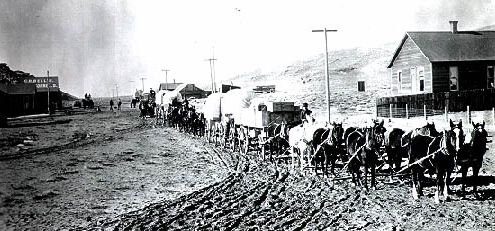 An early visitor to
Rawlins was Harriet White Fisher, the first woman motorist to circle the globe.
She described in her memoir A Woman's World-Tour in a Motor her 1909 passage
through Carbon County in her forty horsepower Locomobile roadster:
An early visitor to
Rawlins was Harriet White Fisher, the first woman motorist to circle the globe.
She described in her memoir A Woman's World-Tour in a Motor her 1909 passage
through Carbon County in her forty horsepower Locomobile roadster:
We passed on through Point of Rocks, and near Bitter Creek had a very disagreeable time,
having to fill in washouts in the road with sagebrush, every few miles.
We crept carefully along through the soft mud, with not a vestige of life
in sight---only miles of desert meeting our view. This place, I believe,
is known as "The Red Desert."
From Bitter Creek we went on to Rawlins. Here we got off the road, and went
around the country about twenty miles to get to Hanna. The road was sandy,
with high centres, and the ground squirrels had burrowed into the ground,
making it dangerous travelling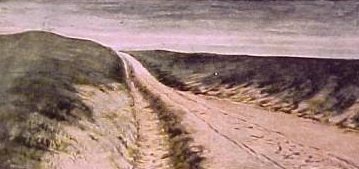 for motorists. Every now and then we would
find ourselves taking a sudden jump as the rear wheels would be buried in
these holes. for motorists. Every now and then we would
find ourselves taking a sudden jump as the rear wheels would be buried in
these holes.
From Hanna, after a great deal of hard pulling, we managed to reach Medicine
Bow. All this time we were obliged to keep our chains on.
Webmaster's note: The chains were not for snow. It was July. In Medicine Bow the
intrepid travelers found no room at the hotel and were required to stay in a
boarding house where the proprietor was drunk and the travelers were awakened
in the middle of the night by the
sounds of the owner attempting to murder his wife. In
contrast, however, as indicated in the photo below, Rawlins had decent accommodations
in the form of the Hotel Ferris, photo at bottom of page.
Oregon Trail, Sweetwater County, 1905, above right
Ms. Fisher was not the only one to complain of the condition of the roads through the
Red Desert. Twelve years later in 1921 two Canadian tourists, Charles and Doretta Beach,
undertook a 10,850 mile odyssey in a brand-new Nash automobile which they picked up
at the factory in Kenosha, Wisc., proceeding across the United States, up to British Columbia,
down to Mexico, onward to Texas, and back to Ontario. In her
diary Mrs. Beach complained that the stretch from Wamsutter to Rock Springs was the
worst of the whole trip. She noted that it took the better part of a day to go
the 115 miles from Rawlins to Rock Springs, and the first 40 miles of that was on a
fine road.
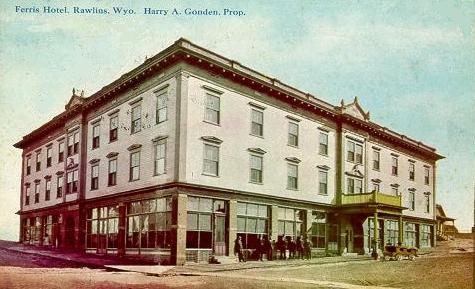
Ferris Hotel, Rawlins, 1910
Note crosswalks. The
Ferris Hotel was constructed by George Ferris. At the time of his death plans
had been made for the construction of his residence at 607 W. Maple. The plans
were carried out by his widow Julia Ferris. The mansion which had declined
over the years has been restored and was recently featured on a cable television
program, Restore America, as were homes in Douglas and Wilson.
|